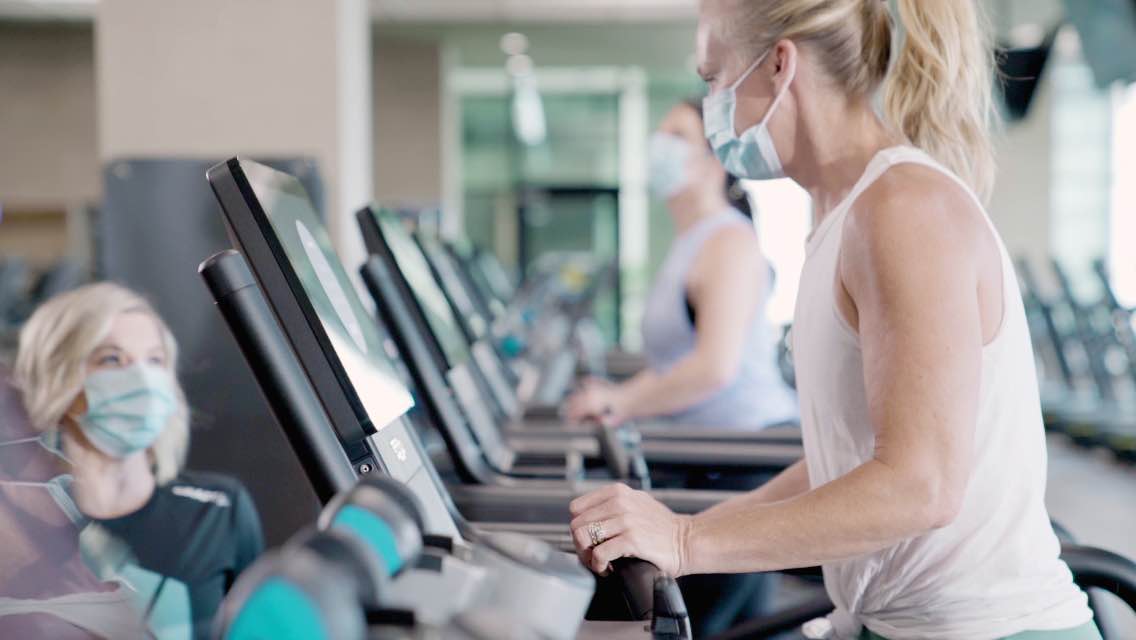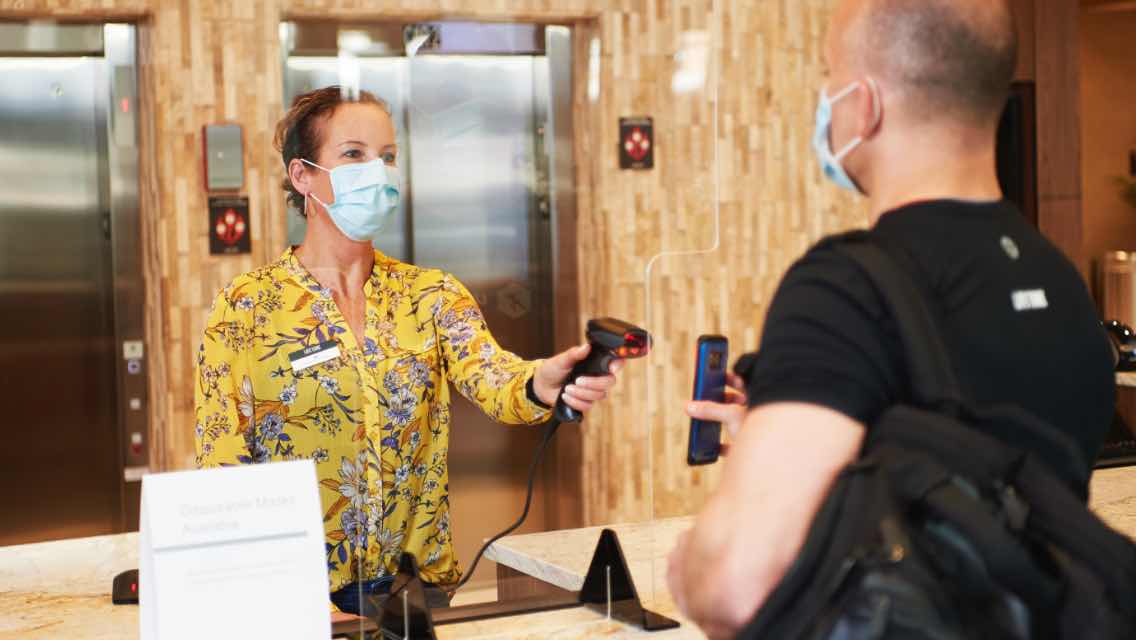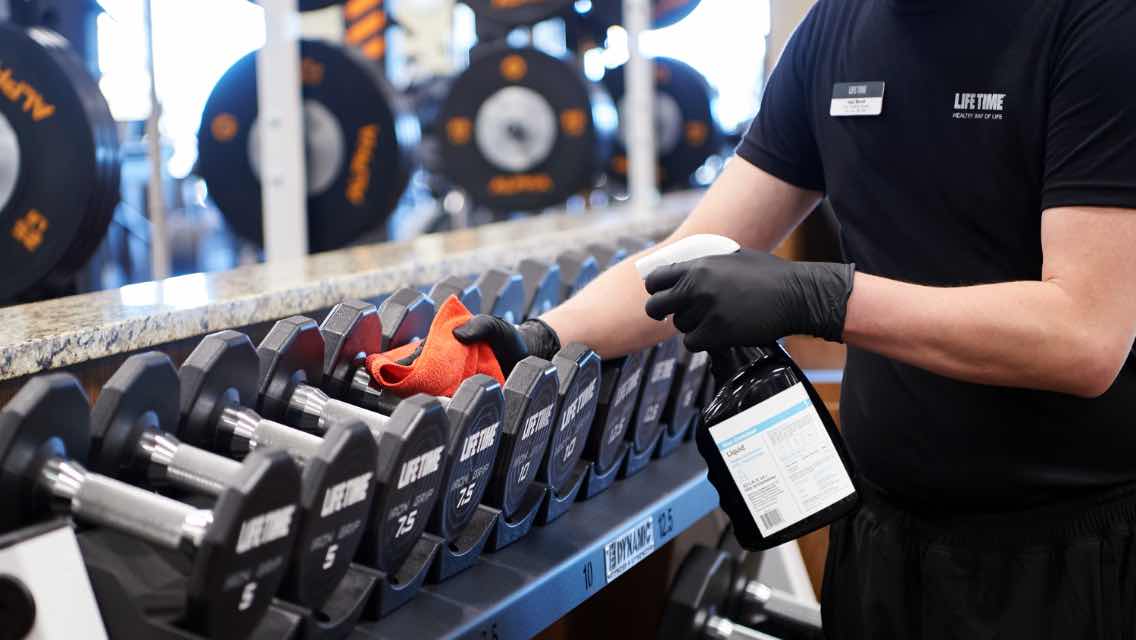Editor’s Note: As of Wednesday, July 22, Life Time has updated its mask requirements in-club and is now requiring masks in all indoor spaces across the country. Guidelines can vary by state, but at minimum, members are expected to wear masks while navigating to and from all areas of the club, including around the fitness floor and studios. For specifics about the mask requirements at your club, visit MyLT.life.
State and local mandates about mask-wearing continue to evolve based on Centers for Disease Control and Prevention (CDC) recommendations to reduce the spread COVID-19 via respiratory droplets. The team at Life Time is intent on supporting your efforts to safely navigate your workout routine and make significant progress toward your healthy-living goals.
There’s no doubt wearing a mask during exercise can be uncomfortable and take some getting used to, but there are ways to adapt. Our experts assembled these helpful insights, tips, and reminders to help you optimize your experience during your next workout.
How to Master Masked Breathing
Contrary to some reports, wearing a cloth face mask doesn’t significantly reduce the amount of oxygen you can breathe in, though it does slow the rate at which you inhale it. Face coverings may also trap more exhaled carbon dioxide (CO2), which could increase the gas in the blood, a scenario known as hypercapnia. In certain circumstances, higher CO2 or lower oxygen may induce adaptive changes in your fitness.
However, for most people, the increase in CO2 does not pose a significant health risk. The challenge for many is simply adjusting to wearing the mask, especially if you struggle with poor breathing patterns or low tolerance — at least initially — to CO2 buildup.
During the adaptation period, any fight-or-flight response can lead to shorter chest breaths and adrenaline production. But there are ways to help mitigate this response.
Danny King, master trainer and national lead for Life Time, offers some simple solutions to these common challenges:
1. Develop proper breathing technique.
Use your diaphragm to breathe instead of your chest: Think of breathing through your back while expanding your ribs. Prone breathing, box breathing, and nasal breathing techniques can all help:
Prone Breathing:
- Step 1: Sit in a comfortable position or lie flat on the floor, your bed, or another comfortable, flat surface.
- Step 2: Relax your shoulders.
- Step 3: Put a hand on your chest and a hand on your stomach.
- Step 4: Breathe in through your nose for about two seconds. You should experience the air moving through your nostrils into your abdomen, making your stomach expand. During this type of breathing, make sure your stomach is moving outward while your chest remains relatively still.
- Step 5: Purse your lips (as if you’re about to drink through a straw), press gently on your stomach, and exhale slowly for about two seconds.
- Step 6: Repeat these steps for several rounds.
Box breathing: Inhale for four seconds, pause and hold your breath for four seconds, then exhale for four seconds. Gradually work up to a box breath of 8 seconds/8 seconds/8 seconds.
- Step 1: Sitting upright, slowly exhale through your mouth, letting all the oxygen out of your lungs. Focus on this intention and be conscious of what you’re doing.
- Step 2: Inhale slowly and deeply through your nose to the count of four. In this step, count to four very slowly in your head. Feel the air fill your lungs, one section at a time, until your lungs are completely full and the air moves into your abdomen.
- Step 3: Hold your breath for another slow count of four.
- Step 4: Exhale through your mouth for the same slow count of four, expelling the air from your lungs and abdomen. Be conscious of the feeling of the air leaving your lungs.
Nasal breathing: With your mouth closed, spend five minutes breathing only through your nose. Try this while performing lower intensity cardio.
2. Improve your ability to exhale to build CO2 tolerance.
When you start wearing a mask during your workouts, you may need to reduce the intensity of sessions, especially cardio. You can also increase rest periods while strength training.
Continue to focus on breathing through your nose and aim for your exhales to be as least as long as your inhales, as that is how CO2 is expelled. Inadequate exhalation of CO2 is the main reason it may accumulate in the bloodstream when wearing a mask.
Pay close attention to your midsection — that is what should expand and contract as you breathe. If your shoulders and chest raise during inhale, you’re probably doing too much chest breathing.
3. Use the power of positive self-talk.
Our thoughts affect not only our minds, but our bodies, too. Consciously and regularly checking in on how you feel as well as using intentional language — “I can” vs. “I can’t” — can help you physically and mentally relax during activity.
Optimize Nutrition for Optimal Oxygen Use
As you train your body to better use your diaphragm for breath work and improved oxygen/carbon dioxide exchange, also consider strategies to amplify the delivery of oxygen to tissues — this can help drive performance.
Master trainer and nutritionist, Samantha McKinney, RD, CPT, shares that “now is a great time to ramp up your intake of the key nutrients your body requires to deliver oxygen to your cells to fuel metabolism and workout performance.” She suggests focusing on the following:
- Vitamin B12, found in seafood, beef, and chicken. Make sure any supplements contain the most active forms of vitamin B12 — methylcobalamin or acetylcobalamin versus cyanocobalamin.
- Folate, found in leafy greens, citrus, and beans. The best form of folate in supplements is not folic acid. Instead, look for 5-methyltetrahydrafolic acid or 5-methyltetrahydrofolate which can be better metabolized and absorbed compared to synthetic folic acid.
- Iron, found in grass-fed red meat and dark-meat poultry. Cooking in cast iron can also support iron levels. To enhance absorption, pair high-iron foods with a source of vitamin C, such as broccoli, bell peppers, or citrus.
- Creatine monohydrate, a safe, well-researched and effective supplement, can also support your body’s ability to produce energy without oxygen during the first several seconds of any activity. Doses of 3 to 5 grams daily, post-workout, is often a good starting point.
Master trainer Paul Kriegler, RD, CPT, explains that our oxygen-carrying capacity also depends on healthy red blood cell development, which requires adequate intake of dietary protein, zinc, essential fatty acids, and a host of other nutritional factors.
He also notes that “cellular uptake and use of oxygen requires healthy mitochondrial function, which also hinges on several essential nutrients and antioxidant capacity.” Consider using 800 mg or more of Beta-Alanine over several weeks; this can boost muscular carnosine levels, which helps improve lactate tolerance.
It may also be a good time to experiment with lower-carbohydrate dietary patterns, too, especially if your workout intensities are lower than usual. Higher intakes of carbohydrates correlate with higher amounts of CO2 produced, so moderating carbs (not eliminating them altogether) may also help you better adjust to wearing a mask during workouts.
For an inside-out approach, periodic, comprehensive lab testing — which we suggest getting done annually — can help you identify potential barriers to healthy aerobic and cellular health.
Practical Tips
At the end of the day, the transition to mask-wearing might take some time — and we’re here to help you adjust as efficiently as possible.
How to pick a mask:
- Choose a version that you’re comfortable wearing while exercising. Both single and multi-layer options are available, and offer varying levels of protection. Your choice is based upon the desire for more layers, which may offer greater protection from respiratory droplets, or a single layer, which may improve breathing during exertion. Of course, wearing any mask in general will reduce the spread of respiratory particulates.
- For homemade masks, recent evidence suggests that combining a layer of high thread count cotton with a layer of silk may offer protection that’s on par with medical-grade masks. Research also shows that vacuum cleaner bag material may offer good protection against the spread of droplets as well.
- Ensure a proper fit — over the nose, not too loose, not too tight. If there are gaps along the edges of the mask where air can escape, the effectiveness decreases substantially.
- Make sure it’s washable. The CDC recommends washing your mask between each use and drying either flat in direct sunlight or on the highest temperature. Follow the care instructions on your mask to maintain its efficacy when you’re wearing it.
Masks are also available for purchase in the Life Time Health Store at shop.lifetime.life.
How to get used to wearing a mask:
For over 20 years, Life Time trainers have had success helping members get acclimated to wearing a mask in preparation for respiratory assessment tests, including the Active Metabolic and Resting Metabolic assessments. They offer these three tips, which translate well into current mask-wearing guidelines:
- Try wearing your mask at home for a period of time to get acclimated to the fit.
- While wearing the mask, focus on nasal breathing as instructed above.
- Continue to mentally remind yourself that while the mask may initially feel strange, you are in fact breathing in oxygen and exhaling carbon dioxide.
Things to do before you head to the club:
Make sure your mask is clean and dry. Bring extra, clean masks to change into in case your mask becomes wet from sweat or heavier breathing. Damp masks are not only less effective, but they may make it more difficult to breathe. (Masks are also available for purchase at the LifeCafe® in your club if you forget yours at home.)
Reminders for working out:
- Initially, you may want to shorten your workouts as you get used to exercising in a mask.
- Adjust the intensity of your workout or increase your rest periods between sets or intervals.
- Change your environment. If there are portions of your workout you can do outside, you may not need to wear your mask in those settings (depending on local mandates).
It goes without saying that if you’re not feeling well, the best choice is to stay home and connect with your healthcare provide on next steps.
As we all navigate our way forward and adjust our etiquette at the club, remember that your health, safety, and fitness are our top priority. While wearing a mask during exercise may not feel ideal, there’s no question that getting in your regular exercise is paramount to your health. Exercising with a mask on is still hands-down better than not exercising at all. We’re here to support you along the way.
We greatly appreciate your support in our efforts to remain open to serve you, while also providing safe and healthy environments for all.




